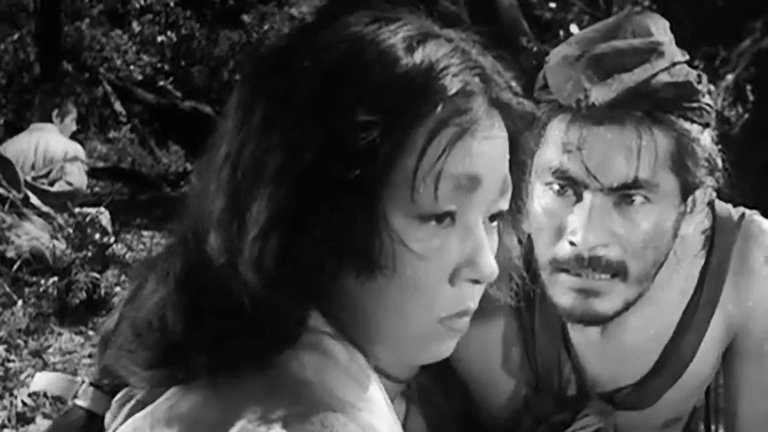Retro Film Review: Rashomon (1950)

Despite gazillions of dollars being spent by Hollywood advertising, movies in good old times movies used to have much bigger social impact than today. At least this is impression a linguist might get from Rashomon, 1950 drama directed by great Japanese director Akira Kurosawa. Apparently, this film was very popular in former Yugoslavia and its name became a new word in (Serbo)Croatian vocabulary, often used for situations when various parties give different accounts of the similar event. Linguistic influence of Rashomon didn't end there. From 1950s word "rašomonac" ("ra-sho-mo-natz") was used for voyeurs in Belgrade slang. This linguistic impact is even more fascinating when if we remember that Rashomon used to be the first Kurosawa's (and, for that matter, Japanese) film that reached Western audience and as such it predated his latter, more popular works like Seven Samurai and Yojimbo.
The plot of the film based on the short stories by famous Japanese writer Ryanosuke Akutagawa. The story is set in medieval Japan and begins in the ruins of Rashomon gate where priest (played by Minoru Chiaki), commoner (played by Kichijiro Ueda) and woodcutter (played by Takashi Shimura) took shelter from pouring rain. In order to let time pass woodcutter and priest start telling the story of the strange events they have witnessed. Local bandit Tajomaru (played by Toshiro Mifune) apparently killed noble Takehiro (played by Masayuki Mori) and raped his beautiful wife Masako (played by Machiko Kyo). Tajomaru is later apprehended and tried but the incident is never explained because all participants - Tajomaru, Masako and Takehiro's soul, summoned through medium (played by Fumiko Honma) - offer different accounts. The woodcutter has witnessed those events and his account is different from other three.
Rashomon is often referenced as one of the most important and most influential films in the history of cinema. This is due to Shinobu Hashimoto's and Kurosawa's script being based around philosophical concept of human's inability to grasp objective truth, which is always, willingly or accidentally, blurred by emotions or different perceptions. Kurosawa built the whole film on this concept and used the medium of filmmaking to introduce new, revolutionary technique of storytelling. Instead of describing the event in straightforward fashion, Kurosawa uses four different perspectives and tells the same story four times. But the result is anything but monotonous or boring, because those different perspectives enrich same simple story and make those four interpretations radically different from each other, leaving the audience with the thankless task to discover which of them is the correct one. Seeing the small, but significant differences in those versions is marvel to watch. Yet, for Kurosawa it represented a whole new challenge. The tone of each version has to be different, musical score has to be different and, last but not least, actors playing principal characters have to play not one but four different roles. Kurosawa was lucky to have small but very talented band of actors at his disposal. Toshiro Mifune, the best known of them, is somewhat disappointing here. His role of small-time psychopathic criminal is played in style that might look too theatrical to our standards. Masayuki Mori, on the other hand, looks almost wooden in comparison, but, thankfully, Machiyo Kyo improves the general impression with four variants of her character. The best role is reserved for Takeshi Shimura, who plays supporting character, very different from the noble warrior he would play in Seven Samurai.
Thanks to good actors, Kurosawa managed to make all those four versions sufficiently different and intriguing enough even for modern day audience, more accustomed to story- telling experiments in filmmaking. But Rashomon is nevertheless the film that shows its age, and its impact might not be as powerful as it was in early 1950s. First of all, the musical soundtrack Fumio Hayasaka is sometimes irritating (especially in segments accompanying Masako's tale; they sound very much like Ravel's "Bolero"). The film have problems with pacing - some scenes are simply overlong, especially the one showing woodcutter walking in the forest before discovering the corpse, and as a result, Rashomon looks much longer than its 88 minutes might indicate. Finally, Kurosawa tries to lighten-up generally depressive tone of the film by introducing abandoned baby in the temple in the end and thus allowing characters to portray general goodness of human beings, despite all of the film's events showing the opposite.
However, despite all of those flaws, Rashomon still presents us with a great cinematic talent at work, and its place in film histories is well justified, same as its imprint in various nations' vocabularies.
RATING: 8/10 (+++)
(Note: The text in its original form was posted in Usenet newsgroup rec.arts.movies.reviews on January 23rd 2002)
==
Blog in Croatian https://draxblog.com
Blog in English https://draxreview.wordpress.com/
Cent profile https://beta.cent.co/@drax
Minds profile https://www.minds.com/drax_rp_nc
Brave browser: https://brave.com/dra011
BTC donations: 1EWxiMiP6iiG9rger3NuUSd6HByaxQWafG
ETH donations: 0xB305F144323b99e6f8b1d66f5D7DE78B498C32A7
Movie URL: https://www.themoviedb.org/movie/548-rash-mon?language=en-US
Critic: AAA
I try to remember this film when i think i "know" something and think im "right" It's not always easy to grasp other peoples version of things and acknowledge them...
Hello @drax, thank you for sharing this creative work! We just stopped by to say that you've been upvoted by the @creativecrypto magazine. The Creative Crypto is all about art on the blockchain and learning from creatives like you. Looking forward to crossing paths again soon. Steem on!